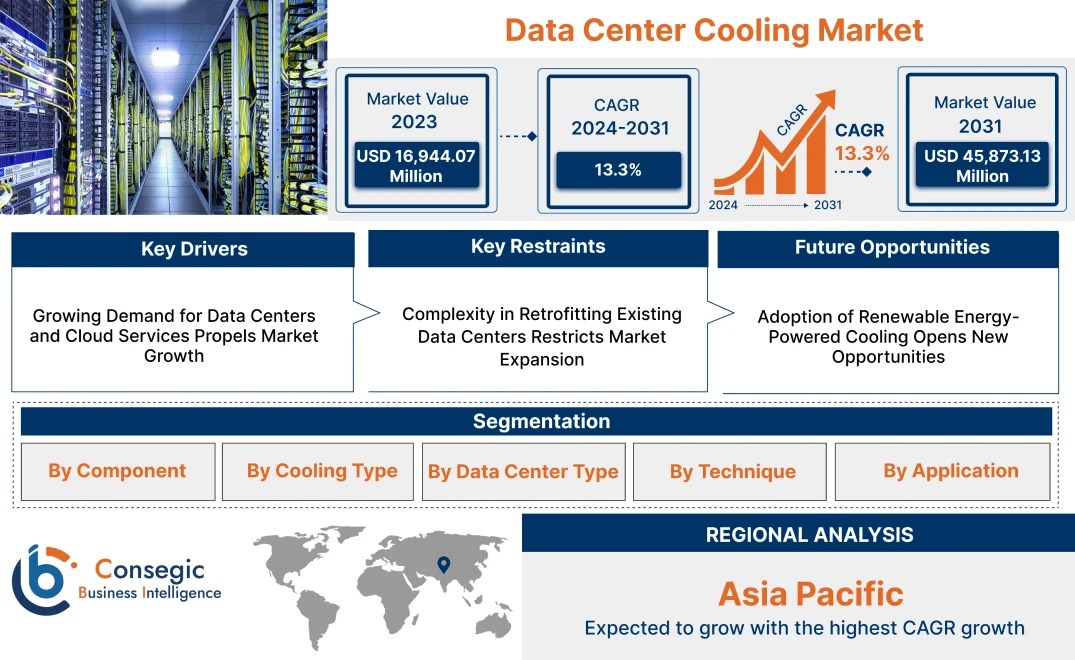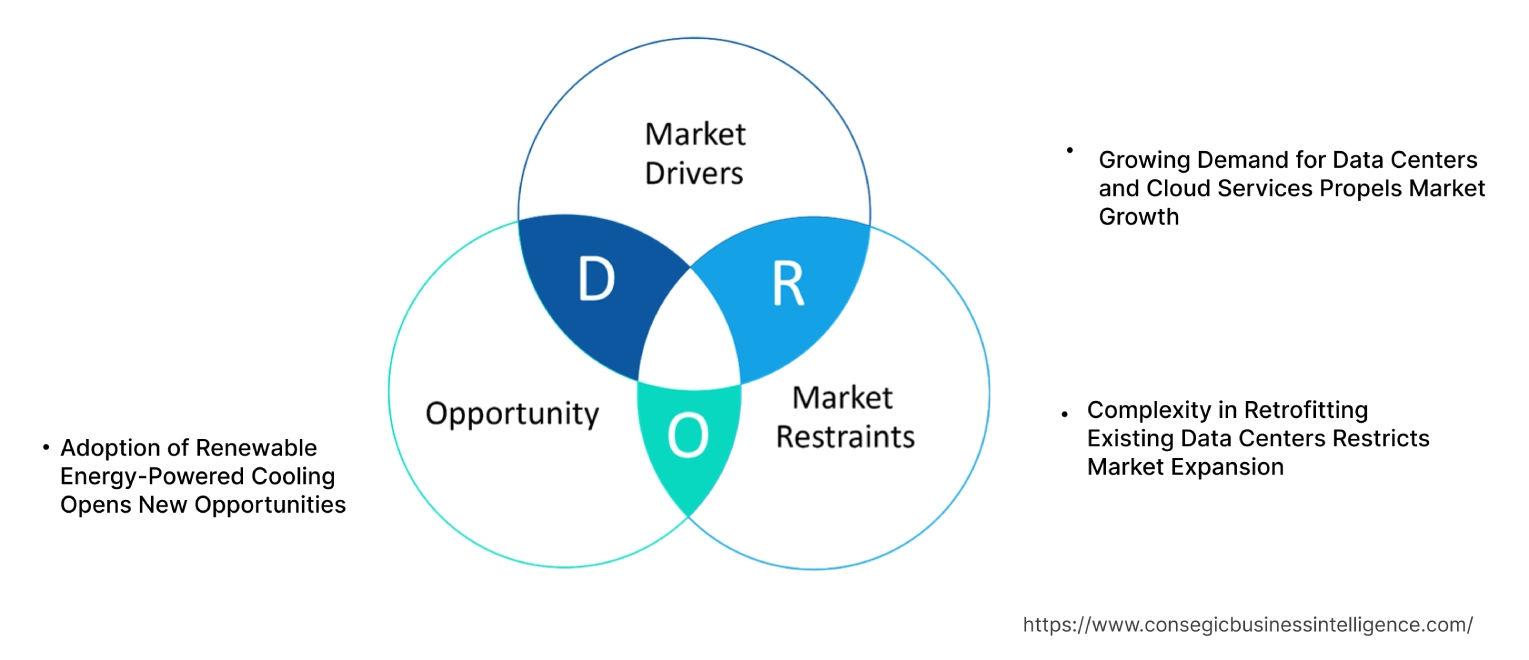Data Center Cooling Market Size:
Data Center Cooling Market size is estimated to reach over USD 45,873.13 Million by 2031 from a value of USD 16,944.07 Million in 2023 and is projected to grow by USD 18,888.57 Million in 2024, growing at a CAGR of 13.3% from 2024 to 2031.
Data Center Cooling Market Scope & Overview:
Data center cooling maintains temperature and humidity levels, which are optimal for data centers, utilizing systems and technologies to ensure the efficiency of servers and IT equipment. The heat generated by high-performance computing hardware is dissipated using these cooling systems, in order to equipment failure and overheating. The advantages range from improved energy efficiency, enhanced equipment longevity, and reduction in operational costs. The key end-use industries include information technology, telecommunications, financial services, and healthcare sectors.
How is AI Transforming the Data Center Cooling Market?
The utilization of AI is significantly transforming the data center cooling market. AI-powered solutions are being used to optimize cooling systems for improved efficiency and performance, particularly in response to the increasing heat generated by workloads. Moreover, the integration of AI can predict potential issues, optimize airflow, and adjust cooling parameters in real-time, which further contributes to reduced energy consumption, lower operational costs, and increased reliability. Therefore, the aforementioned factors are expected to positively impact the market growth in the upcoming years.
Data Center Cooling Market Insights:
Data Center Cooling Market Dynamics - (DRO) :
Key Drivers:
Growing Demand for Data Centers and Cloud Services Propels Market Growth
The massive amount of data produced by organizations, using cloud services requires infrastructures like data centers to manage and monitor the data produced. The rapid shift towards digital transformation and the adoption of advanced technologies like data analytics and machine learning contribute to the adoption of data centers.
Moreover, with the growing data center sizes and densities, energy-efficient solutions are continuously being intensified.
- In October 2023, the advanced waterless cooling system was built by ThermalWorks in order the handle the IT loads which are high-densityensuring to conservation of water resources. It supports almost up to 70 kW per rack along with air cooling and 200 kW per rack with the integration of plug-and-play liquid cooling.
Key Restraints :
Complexity in Retrofitting Existing Data Centers Restricts Market Expansion
The high densities of the modern equipment are not suitable for many of the legacy data centers, with their outdated cooling systems. This makes it impossible for the new energy-efficient cooling systems to be utilized for retrofitting these centers. Moreover, the accommodation of modern cooling systems is difficult, as the space and infrastructure within older data centers are much smaller. The cost of retrofitting further restricts the market. Therefore, the cost and space-related issues of retrofitting restrict the data center cooling market demand.
Future Opportunities :
Adoption of Renewable Energy-Powered Cooling Opens New Opportunities
The increase in environmental concerns shifts the market towards integrating cooling systems that are renewable energy-powered, reducing overall energy consumption and carbon emissions. These cooling systems include solar, wind, or geothermal energy, maintaining operational efficiency by minimizing the environmental impact. Additionally, they significantly reduce the operational cost over time, along with meeting the regulatory standards, which makes them the sustainable solution viable in the long term.
- In September 2022, a new DOWSIL™ Immersion Cooling Technology was launched by Dow . This was to ensure data center sustainability and efficiency meeting the high-speed and high-volume data communication requirements.
Thus, the move towards sustainable solutions, especially with cooling systems boosts the data center cooling market opportunities.
Data Center Cooling Market Segmental Analysis :
By Component:
Based on components, the market is segmented into, Air Conditioning, Chillers, Economizers, Cooling Towers, Air Handling Units (AHUs), Precision Air Conditioners, and Others.
Trends in the component:
- New chiller technologies are developed to increase energy efficiency in data centers, along with which free-cooling economizers are also combined with cooling towers which use outside air to reduce the need for mechanical refrigeration.
- Precision air conditioners are now equipped with advanced technologies like real-time monitoring and AI-driven optimization features which help by maintaining ideal thermal conditions for sensitive server hardware.
The Air Conditioning segment accounted for the largest revenue share of the total data center cooling market share in 2023.
- Air conditioning systems play a critical role in regulating the temperature and maintaining optimal conditions in data centers. They are needed to maintain the performance and longevity of servers.
- The efficiency of modern air conditioning systems is getting better through innovations like modular design and intelligent cooling algorithms, which help in reducing energy consumption at the same time improve cooling precision.
- Additionally, smart air conditioning units now come equipped with IoT sensors, which equip them with real-time monitoring and adjustments to ensure consistent cooling performance.
- These advanced cooling technologies reduce operational costs, helping large-scale data centers operate efficiently while maintaining sustainable energy practices.
- For instance, the precision air-conditioning units by Weiss Technik control the air temperature supply and operate in an energy-efficient way. They are specially made for data centers and the intelligent control allows them to react to temperature fluctuations which are unforeseen.
- In conclusion, the widespread adoption of smart, energy-efficient air conditioning systems drives the data center cooling market growth.
The Liquid-Based Cooling segment is anticipated to register the fastest CAGR during the forecast period.
- Liquid-based cooling involves the use of liquids like water or specialized coolants to transfer heat away from servers more efficiently than traditional air-based systems.
- This cooling method is mostly suited for high-density data centers where traditional air cooling may not suffice due to the increased heat generated by high-performance computing (HPC) systems.
- The rise in popularity of AI and machine learning workloads has increased the need for efficient cooling solutions that can handle the increased thermal output of GPUs and other processing units.
- Liquid cooling makes the system perform at higher clock speeds with reduced energy consumption, which makes it a sustainable option for next-generation data centers.
- In conclusion, the segmental analysis shows that the increasing need for high-efficiency cooling solutions to support AI and HPC workloads will drive the rapid usage of liquid-based cooling systems in the coming years.
By Cooling Type :
Based on cooling type, the market is trifurcated into Room-Based Cooling, Rack-Based Cooling, and Row-Based Cooling.
Trends in the Cooling Type:
- Row-based cooling is now being used with AI-driven airflow management, which makes sure that cooling resources are directed to the rows with the highest heat loads. This optimizes efficiency and reduces energy consumption.
- Hybrid row-based cooling systems which combine liquid and air cooling are now under development which will further enhance performance, particularly in data centers handling AI and HPC workloads.
The room-based cooling segment accounted for the largest revenue of 59.29% in 2023.
- Room-based cooling systems are widely used in traditional data centers, where cooling is provided to the entire room instead of specific racks or rows.
- These systems are ideal for large-scale facilities where there is a uniform heat load and where airflow management can be optimized.
- Modern room-based cooling systems are now equipped with feature variable speed fans and sensors that can automatically adjust airflow to balance cooling needs across the entire facility, improving overall energy efficiency and reducing the overall operational cost.
- The combination of cost-effectiveness and simplicity in design makes room-based cooling a preferred choice for larger data centers.
- For instance, in order to ensure efficient thermal management, the room-based direct expansion floor-mount cooling unit was designed by Vertiv™ Liebert® PDX. Across various installation configurations, it delivers extremely high performance, with 15 to 165 kW capabilities.
- In conclusion, despite innovations in other cooling techniques, room-based cooling remains dominant due to its established use in large facilities and its continued evolution toward greater energy efficiency.
The rack-based cooling segment is anticipated to register the fastest CAGR during the forecast period.
- Rack-based cooling works better on cooling individual server racks because it offers precise temperature control and efficient cooling for high-density deployments.
- As data centers progress and become better which enables them to handle more compact and powerful servers, rack-based cooling is gaining popularity because of its ability to target heat directly at the source, which reduces the need for broad cooling efforts.
- The rise of cloud computing and edge computing solutions has increased the usage of high-density data centers, in which rack-based cooling solutions can deliver the necessary cooling capacity without using excessive energy consumption.
- Rack-based cooling also offers a modular approach, making it easier to scale up as data center requirements grow.
- In conclusion, the rise of high-density data centers and cloud infrastructure utilizes rack-based cooling and thus, in turn, drives the data center cooling market trends.
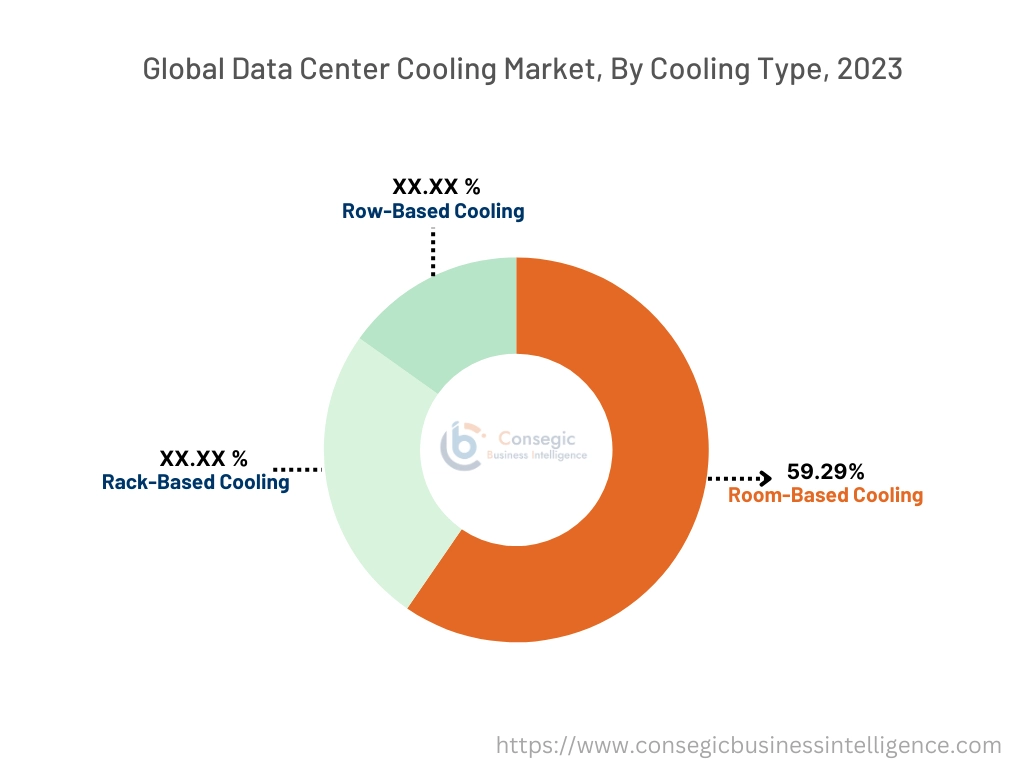
By Data Center Type:
Based on data center type, the market is segmented based on, Enterprise Data Centers, Colocation Data Centers, Hyperscale Data Centers, and Edge Data Centers.
Trends in the Data Center Type:
- New developments in enterprise data centers include integrating hybrid cloud solutions, which allow businesses to seamlessly manage both on-premises and cloud-based infrastructure.
- Colocation centers are evolving to support high-density deployments, offering flexible power and cooling solutions tailored to the needs of individual clients, enhancing their appeal to growing businesses.
The Hyperscale Data Centers accounted for the largest revenue share in 2023.
- Hyperscale data centers are designed to scale up quickly and handle massive amounts of data, typically used by large cloud providers and enterprises.
- These data centers leverage modular design, automation, and sophisticated cooling technologies to deliver high performance at reduced costs.
- The increased adoption of cloud services, AI, and IoT has fueled the demand for hyperscale data centers, as they provide the necessary infrastructure to support these technologies.
- Hyperscale facilities often incorporate advanced power management systems and cooling technologies, allowing them to operate efficiently even as they expand.
- In conclusion, analysis of segment shows that hyperscale data centers will continue to dominate the market due to their scalability and ability to support the growing demand for cloud computing and AI applications.
The Edge Data Centers sector is anticipated to register the fastest CAGR during the forecast period.
- Edge data centers bring computing power closer to the source of data, also reducing latency and improving the performance of real-time applications such as autonomous vehicles and IoT devices.
- These data centers are compact and distributed but play a crucial role in managing and processing data in industries that require ultra-low latency and high-speed data transfer.
- The rise in 5G deployments has accelerated the adoption of edge data centers, as they are essential for supporting the network's low-latency requirements.
- Edge data centers are designed to be compact, energy-efficient, and rapidly deployable, making them ideal for industries with geographically dispersed operations.
- In 2023, a fully automated edge data center by Finland's Elisa with Wind River Studio Conductor. Elisa's 5G core UPF application is used for managing network performance while a cloud-native, Kubernetes, and container-based architecture is provided by Wind River Studio for developing, deploying, and servicing distributed Edge networks at scale.
- In conclusion, the rapid expansion of 5G and the need for real-time data processing will drive the data center cooling market trends in the coming years.
By Technique:
Based on technique, the market is segmented based on, including Air-Based Cooling, Liquid-Based Cooling, and Immersion Cooling.
Trends in the Technique:
- New developments in liquid-based cooling also include the use of biodegradable coolants, enhancing the sustainability of this already energy-efficient cooling technique.
- Combining air-based and liquid-based cooling is becoming more popular, particularly for high-density data centers where a mix of cooling approaches is necessary to handle varying heat loads.
Air-Based Cooling accounted for the largest revenue of the total data center cooling market share in 2023.
- Air-based cooling remains the most commonly used technique, relying on the circulation of cool air to maintain optimal temperatures for servers and other equipment.
- Advanced air-based cooling systems now feature variable-speed fans, which adjust airflow based on real-time temperature data, ensuring that cooling is delivered where it is needed most.
- This technique is well-suited for data centers where server racks are spread out and require broad coverage to ensure all equipment operates within safe thermal limits.
- Air-based cooling's flexibility and relatively low cost make it a preferred option for many data centers, especially in moderate climates where extreme cooling is not necessary.
- In conclusion, despite the rise of newer techniques, air-based cooling remains a dominant method due to its adaptability and cost-effectiveness in large data centers, driving the data center cooling market demand.
The Immersion Cooling sector is anticipated to register the fastest CAGR during the forecast period.
- Immersion cooling involves submerging servers directly into non-conductive liquid coolants, offering unparalleled cooling efficiency compared to air or liquid-based systems.
- This technique is ideal for high-performance computing environments where traditional cooling methods may struggle to keep up with heat dissipation needs.
- Immersion cooling is also gaining traction due to its ability to reduce overall energy consumption and improve sustainability by lowering the need for energy-intensive air conditioning.
- As the need for high-density, energy-efficient data centers grows, immersion cooling will become an increasingly attractive solution for both large and small-scale deployments.
- In October 2023, data center immersion cooling fluids were launched by ExxonMobil. It reduces the cost of IT equipment ownership by 40%.
- In conclusion, the segmental analysis depicts that the superior cooling efficiency and sustainability of immersion cooling will drive its rapid adoption in high-performance data centers, boosting the data center cooling market opportunities.
By Application:
Based on cooling type, the market is segmented into BFSI, IT and Telecom, Healthcare, Government and Defense, Energy, Retail, and Others.
Trends in the Application:
- Increased investments in cybersecurity and the modernization of defense systems are driving the need for secure colocation facilities, capable of handling classified and mission-critical data.
- With the rise of renewable energy and smart grid technologies, the energy sector requires colocation services to process real-time data generated by IoT devices and smart meters.
- E-commerce growth and the digital transformation of retail operations have increased the requirement for data storage and processing capabilities, leading to greater adoption of colocation services within the retail sector.
IT and Telecom accounted for the largest revenue share in 2023.
- The IT and telecom industry relies heavily on data centers to store and manage the vast amounts of data generated by cloud services, mobile applications, and enterprise networks.
- With the rapid expansion of 5G networks, data centers play a pivotal role in processing the immense data load generated by connected devices and applications.
- Additionally, the growing trend of remote work and digital transformation has pushed IT and telecom companies to seek colocation services for scalable and secure data storage solutions.
- In 2023, the next-gen immersion-cooled data centers launch in the Middle East was announced by GRC and DCV. This ensures to meet the demands for eco-friendly data centers, by using reducing environmental impact using resilient solutions.
- In conclusion, the IT and telecom industry's increasing data needs and technological advancements have solidified its dominant position in the data center colocation market.
The Healthcare sector is anticipated to register the fastest CAGR during the forecast period.
- The healthcare industry is increasingly adopting digital technologies such as electronic health records (EHRs), telemedicine, and AI-driven diagnostics, all of which generate vast amounts of sensitive data.
- As healthcare providers modernize their infrastructure, the need for secure, scalable, and compliant data storage solutions has fueled the usage of colocation services.
- The healthcare sector requires colocation services to ensure data privacy, regulatory compliance (such as HIPAA in the U.S.), and disaster recovery capabilities.
- The growing adoption of precision medicine and genomics further amplifies the need for advanced data centers capable of handling large volumes of healthcare data.
- In conclusion, the healthcare sector's shift towards digitization and data-driven decision-making is expected to promote data center cooling market expansion.
Regional Analysis:
The regions covered are North America, Europe, Asia Pacific, the Middle East and Africa, and Latin America.
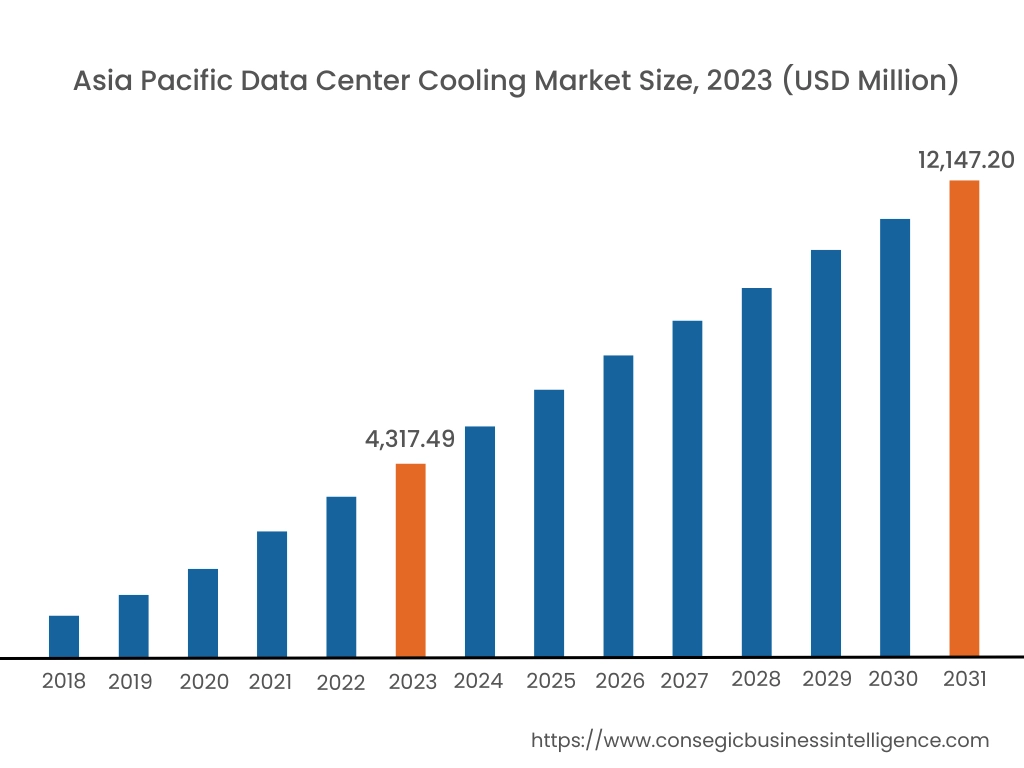
Asia Pacific region was valued at USD 4,317.49 Million in 2023. Moreover, it is projected to grow by USD 4,828.69 Million in 2024 and reach over USD 12,147.20 Million by 2031. Out of this, China accounted for the maximum revenue share of 31.8%. As per the data center cooling market analysis, the growth is driven by the exponential increase in digitalization and the adoption of advanced technologies like artificial intelligence. The growing rate of internet penetration and online services in the data-driven industries, requires cooling technologies leading to large-scale data center construction, especially in countries like China, Japan, and India.
- In 2023, a new container-type data center was launched by MHI which also includes an immersion/air-cooled hybrid cooling system. It is a 40kVA-class 12ft container-type data center that utilizes three types of cooling methods namely immersion cooling (25kVA), air cooling (8kVA), and water cooling (8kVA).
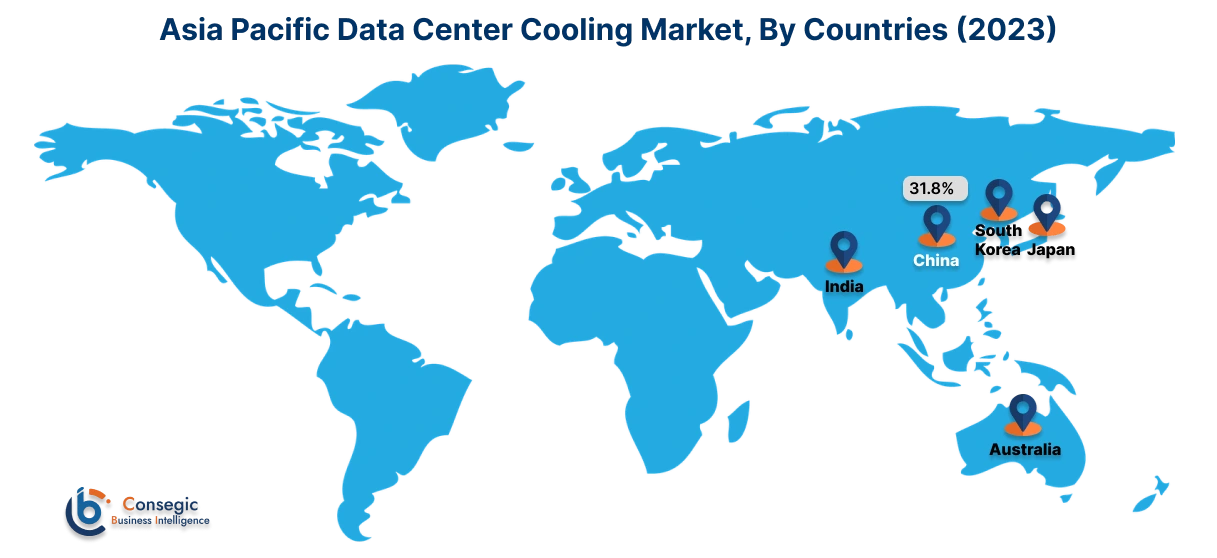
North America is estimated to reach over USD 15,541.82 Million by 2031 from a value of USD 5,694.05 Million in 2023 and is projected to grow by USD 6,351.83 Million in 2024. The growth is due to the rapid adoption of cloud computing and advances in the sector, along with the expansion of data center construction across the region. There is an increasing shift towards hyperscale data centers due to the innovations in cloud-based services, which require cooling systems for optimizing performance and prevention of downtime.
- In 2022, due to the rapid expansion of data center designs, a dedicated cooling optimizer solution was launched Modine of Airedale. The Cooling System OptimiserTM solution gives efficient performance across chilled water cooling systems in large data centers.
In Europe, the stringent regulations for energy efficiency by the European Union (EU) are the primary driving factors for market expansion. The adoption of advanced cooling systems is due to these regulations, to reduce energy consumption. The data center cooling market analysis shows that the rising investments in data center infrastructure, especially in countries like UAE and South Africa drive the market in the Middle East and Africa. Technological advancements and the adoption of the internet are the contributing factors. The increase in the adoption of cloud computing services especially in Brazil and Mexico surges the data center cooling market expansion in Latin America.
The rise in cooling technologies meets the data storage and processing needs in this region.
Top Key Players & Market Share Insights:
The data center cooling market is highly competitive with major players providing data center cooling services to the national and international markets. Key players are adopting several strategies in research and development (R&D), product innovation, and end-user launches to hold a strong position in the global data center cooling market. Key players in the data center cooling industry include -
- Schneider Electric (France)
- Vertiv Group Corp. (USA)
- Rittal Pvt. Ltd. (Germany)
- Delta Electronics, Inc. (Taiwan)
- Airedale International Air Conditioning LTD. (UK)
- STULZ GmbH (Germany)
- Huawei Technologies Co., Ltd. (China)
- Fujitsu (Japan)
- Nortek Air Solutions, LLC. (USA)
- Trane Technologies plc (Ireland)
Recent Industry Developments :
Product launches:
- In May 2023, "Liebert PKDX" was launched by Vertiv, especially for the Indian Market. They include intelligent controls, rack sensors, and central optimizing system control that enables the optimization of data center thermal management.
- In April 2024, CO₂-based higher capacity cooling units were launched by M&M Carnot for data centers. The benefits of this technology include a low ODP and GWP, a smaller footprint compared to synthetics due to its higher heat capacity, comparable installation costs, and potential energy savings.
- In April 2024, a two-phase direct-to-chip liquid cooling technology was launched by Accelsius, an Innventure Company for data centers. The NeuCoolTM system gives optimal thermal performance for powerful processors that are backed with AI, machine learning, high-performance computing, and other intensive workloads.
Mergers & Acquisitions:
- In July 2024, Geoclima was acquired by Munters to expand its energy-efficient data center cooling solutions portfolio. The chiller technology of Geoclima can be utilized by Munters with this acquisition.
- In May 2023, the acquisition of the liquid cooling pioneer CoolIT Systems by KKR was announced. This aims to meet the sustainability demands of integrating AI and ensure the growth of high-density hardware in data centers.
Partnerships & Collaborations:
- In February 2024, Iceotope and SK Telecom collaborated with SK Enmove, to expand their portfolio to the liquid cooling market. Iceotope's Precision Liquid Cooling (PLC) solution will be loaded by SK Enmove's thermal fluids and integrated into SK Telecom's AI Data Center Testbed (AI DC Testbed).
Data Center Cooling Market Report Insights :
| Report Attributes | Report Details |
| Study Timeline | 2018-2031 |
| Market Size in 2031 | USD 45,873.13 Million |
| CAGR (2024-2031) | 13.3% |
| By Component |
|
| By Cooling type |
|
| By Data Center Type |
|
| By Technique |
|
| By Application |
|
| By Region |
|
| Key Players |
|
| North America | U.S. Canada Mexico |
| Europe | U.K. Germany France Spain Italy Russia Benelux Rest of Europe |
| APAC | China South Korea Japan India Australia ASEAN Rest of Asia-Pacific |
| Middle East and Africa | GCC Turkey South Africa Rest of MEA |
| LATAM | Brazil Argentina Chile Rest of LATAM |
| Report Coverage |
|
Key Questions Answered in the Report
How big is the Data Center Cooling Market? +
Data Center Cooling Market size is estimated to reach over USD 45,873.13 Million by 2031 from a value of USD 16,944.07 Million in 2023 and is projected to grow by USD 18,888.57 Million in 2024, growing at a CAGR of 13.3% from 2024 to 2031.
What specific segmentation details are covered in the data center cooling market report? +
The data center cooling market report includes specific segmentation details for components, cooling type, data center type, technique, application, and region.
Which is the fastest segment anticipated to impact the market growth? +
In the application segment, the healthcare sector is the fastest-growing segment during the forecast period due to the improved scalability and advancement in technology.
Who are the major players in the data center cooling market? +
The key participants in the data center cooling market are Schneider Electric (France), Vertiv Group Corp. (USA), STULZ GmbH (Germany), Rittal Pvt. Ltd. (Germany), Delta Electronics, Inc. (Taiwan), Airedale International Air Conditioning LTD. (UK), Huawei Technologies Co., Ltd. (China), Fujitsu (Japan), Nortek Air Solutions, LLC. (USA), Trane Technologies plc (Ireland)
